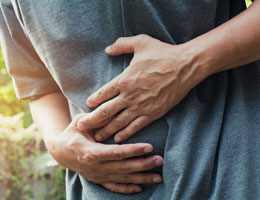
The gallbladder is a sacklike organ that lies in the upper right portion of the abdomen, just under the liver. You can live without it, and that's a good thing. According to the National Institute of Diabetes and Digestive and Kidney Diseases (NIDDK), surgery to remove the gallbladder is one of the most common operations performed on adults in the U.S.
These surgeries are the most effective treatment for gallstones—small, pebblelike objects that form in the gallbladder and are found in nearly a million Americans every year.
How gallstones form
Gallstones form from bile, which is made by the liver and stored in the gallbladder. After a meal, the gallbladder contracts to force bile into the intestine to aid in digestion.
Bile contains substances, including cholesterol and a waste product called bilirubin, and most gallstones form from an excess of cholesterol that crystallizes and then hardens into stones, according to the American College of Gastroenterology. The rest—called pigment stones—form when an excess of bilirubin crystallizes and hardens.
Gallstones can range from the size of a grain of sand to the diameter of a golf ball. There may be hundreds of tiny stones, one large one or a combination.
Symptoms of gallstones
Some gallstones don't cause symptoms and don't need to be treated. When symptoms do occur, they most often start with severe, steady pain in the upper abdomen or right side—probably from a stone blocking the duct that drains the gallbladder.
Some people feel pain from gallstones between their shoulder blades or in their right shoulder. It may go away in about 15 minutes or last several hours. Vomiting and sweating may also occur with gallstones.
These symptoms often follow heavy meals. They are called gallbladder attacks because they usually occur suddenly.
Risk factors
Some people are more likely than others to develop gallstones. According to the NIDDK and the American Gastroenterological Association (AGA), the risk is higher among people who:
- Are female.
- Have lost a lot of weight quickly.
- Are older than 40.
- Are overweight or obese.
- Have diabetes.
- Take medication to lower cholesterol.
- Have a family history of gallstones.
Treating gallstones
A person with symptoms of gallstones will probably have an ultrasound exam to diagnose the problem. If you have gallstones and are having frequent attacks, your doctor will probably recommend that you have surgery to remove your gallbladder, reports the NIDDK.
This surgery is called cholecystectomy, and it's the most common treatment for gallstones. It's usually done with laparoscopy, which uses several tiny incisions in the abdomen. The surgeon inserts a miniature video camera and removes the gallbladder with very small instruments. People tend to recover faster from laparoscopic surgery than from traditional open surgery and have less pain, according to the AGA.
Sometimes, though, open surgery may be necessary. This could happen if there are complications from the gallstones, such as severe inflammation or infection. More serious complications can happen if the gallstone passes out of the gallbladder and becomes lodged in another duct, causing problems with the duct or the pancreas.
After the gallbladder is removed, the bile flows from the liver to the intestines without first being stored. People generally do well without a gallbladder and have no trouble digesting food.
People at high risk for complications during surgery, such as people with heart problems or lung disease, may be treated with a medication to dissolve gallstones or sound waves to break them up. However, gallstones usually return if they aren't treated with surgery, according to the American Academy of Family Physicians.
If you have gallstones, you and your doctor will decide on the treatment that's best for you.
Reviewed 10/25/2024